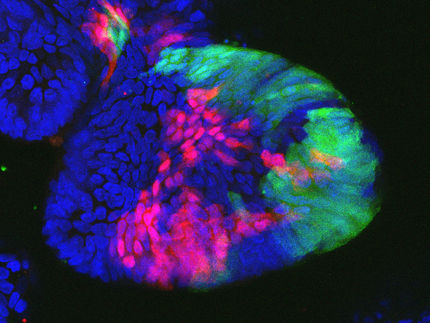More precise Cas9 variant
More specific CRISPR-Cas9 gene scissors makes genome editing even more precise
CRISPR-Cas9 has revolutionized the field of genetics by its ability to cut DNA at defined target sites. Researchers are using the Cas9 enzyme to specifically switch off genes, or insert new DNA fragments into the genome. But no matter how specific the Cas9 enzyme is – sometimes it cuts where it shouldn’t. Scientists at the Max Planck Unit for the Science of Pathogens in Berlin and the Faculty of Medicine of the Martin Luther University Halle-Wittenberg now report a Cas9 variant that increases the specificity of genome editing.

Structure of Cas9 bound to a single guide RNA (framework in dark grey, spacer in yellow) and a DNA target strand (purple). The modification of the amino acid residue Q768 (orange, dashed box) results in a more specific Cas9 variant.
© Bratovic et al., 2020
In order for Cas9 to cut a DNA target, it needs to be directed to the target site by what is called a guide RNA. The guide RNA contains the complementary sequence to the DNA target site, working like a ZIP Code to guide Cas9 to its target. "Sometimes, however, Cas9 can also cut DNA sequences that are very similar to the actual target, known as off-targets," explains Emmanuelle Charpentier, director of the Max Planck Unit for the Science of Pathogens.
This undesired activity of CRISPR-Cas9 can lead to inaccuracies in genome editing. "An unintended cut at the wrong place in the human genome can have profound consequences. That is why we need a more specific system," says Michael Böttcher, Assistant Professor at the Medical Faculty of the Martin Luther University.
Scientists are therefore trying to optimize Cas9 specificity using different approaches. In the current study, the team of researchers from Berlin and Halle focused on an evolutionarily conserved domain of Cas9, known as bridge helix.
Amino acids form stable loop
The researchers found that the bridge helix plays a critical role in the mechanism by which Cas9 interacts with its guide RNA and DNA target site. They identified a group of amino acid residues that make contact with the phosphate backbone of the guide RNA, thereby facilitating the formation of a stable loop, which is essential for the activity of Cas9. In such a loop, the Cas9-bound guide RNA pairs with the complementary strand of the DNA target sequence while displacing the second DNA strand, thereby enabling Cas9 to cut both DNA strands.
The researchers generated new Cas9 variants by changing these amino acid residues and found that several variants cut much less frequently at off-target sites than the original Cas9 enzyme. They further show that one of the identified variants, called R63A/Q768A, increased the gene editing specificity of Cas9 also in human cells. "Our results provide a new basis for further optimization of CRISPR-Cas9. They demonstrate the need to gain more knowledge about the biochemistry of CRISPR-Cas systems to further improve them", says Charpentier.
Original publication
Bratovic M, Fonfara I et al.; "Bridge Helix Arginines Play a Critical Role in Cas9 Sensitivity to Mismatches"; Nat. Chem. Biol.; 2 March, 2020
Most read news
Original publication
Bratovic M, Fonfara I et al.; "Bridge Helix Arginines Play a Critical Role in Cas9 Sensitivity to Mismatches"; Nat. Chem. Biol.; 2 March, 2020
Organizations
Other news from the department science

Get the analytics and lab tech industry in your inbox
By submitting this form you agree that LUMITOS AG will send you the newsletter(s) selected above by email. Your data will not be passed on to third parties. Your data will be stored and processed in accordance with our data protection regulations. LUMITOS may contact you by email for the purpose of advertising or market and opinion surveys. You can revoke your consent at any time without giving reasons to LUMITOS AG, Ernst-Augustin-Str. 2, 12489 Berlin, Germany or by e-mail at revoke@lumitos.com with effect for the future. In addition, each email contains a link to unsubscribe from the corresponding newsletter.





















































